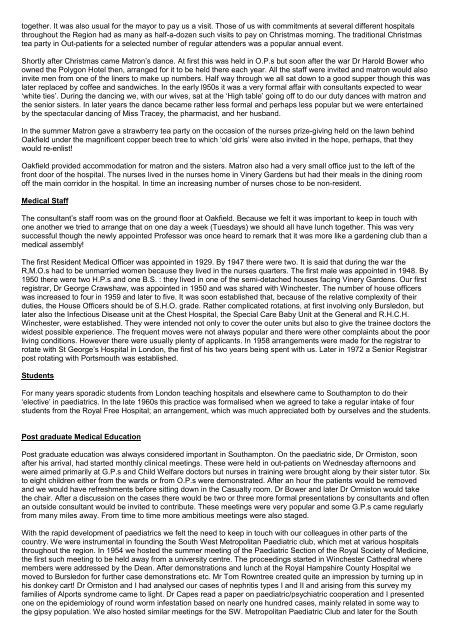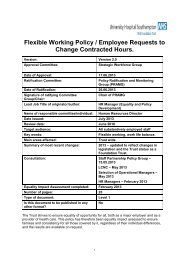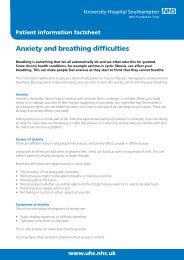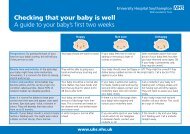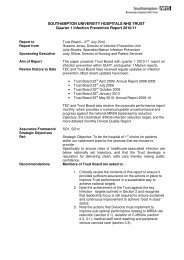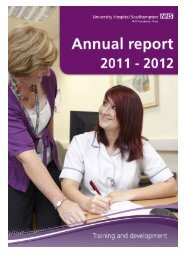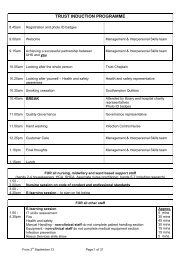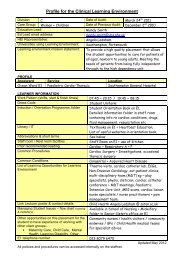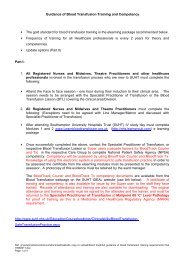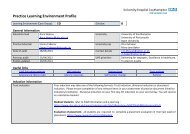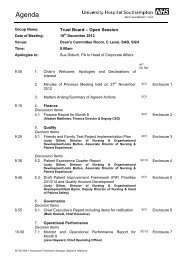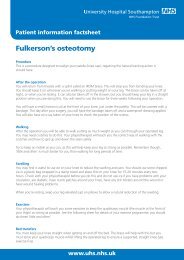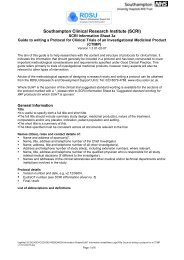ninety years of service - University Hospital Southampton NHS ...
ninety years of service - University Hospital Southampton NHS ...
ninety years of service - University Hospital Southampton NHS ...
- No tags were found...
You also want an ePaper? Increase the reach of your titles
YUMPU automatically turns print PDFs into web optimized ePapers that Google loves.
together. It was also usual for the mayor to pay us a visit. Those <strong>of</strong> us with commitments at several different hospitalsthroughout the Region had as many as half-a-dozen such visits to pay on Christmas morning. The traditional Christmastea party in Out-patients for a selected number <strong>of</strong> regular attenders was a popular annual event.Shortly after Christmas came Matron’s dance. At first this was held in O.P.s but soon after the war Dr Harold Bower whoowned the Polygon Hotel then, arranged for it to be held there each year. All the staff were invited and matron would alsoinvite men from one <strong>of</strong> the liners to make up numbers. Half way through we all sat down to a good supper though this waslater replaced by c<strong>of</strong>fee and sandwiches. In the early l950s it was a very formal affair with consultants expected to wear‘white ties’. During the dancing we, with our wives, sat at the ‘High table’ going <strong>of</strong>f to do our duty dances with matron andthe senior sisters. In later <strong>years</strong> the dance became rather less formal and perhaps less popular but we were entertainedby the spectacular dancing <strong>of</strong> Miss Tracey, the pharmacist, and her husband.In the summer Matron gave a strawberry tea party on the occasion <strong>of</strong> the nurses prize-giving held on the lawn behindOakfield under the magnificent copper beech tree to which ‘old girls’ were also invited in the hope, perhaps, that theywould re-enlist!Oakfield provided accommodation for matron and the sisters. Matron also had a very small <strong>of</strong>fice just to the left <strong>of</strong> thefront door <strong>of</strong> the hospital. The nurses lived in the nurses home in Vinery Gardens but had their meals in the dining room<strong>of</strong>f the main corridor in the hospital. In time an increasing number <strong>of</strong> nurses chose to be non-resident.Medical StaffThe consultant’s staff room was on the ground floor at Oakfield. Because we felt it was important to keep in touch withone another we tried to arrange that on one day a week (Tuesdays) we should all have lunch together. This was verysuccessful though the newly appointed Pr<strong>of</strong>essor was once heard to remark that it was more like a gardening club than amedical assembly!The first Resident Medical Officer was appointed in 1929. By 1947 there were two. It is said that during the war theR,M.O.s had to be unmarried women because they lived in the nurses quarters. The first male was appointed in 1948. By1950 there were two H.P.s and one B.S. : they lived in one <strong>of</strong> the semi-detached houses facing Vinery Gardens. Our firstregistrar, Dr George Crawshaw, was appointed in 1950 and was shared with Winchester. The number <strong>of</strong> house <strong>of</strong>ficerswas increased to four in 1959 and later to five. It was soon established that, because <strong>of</strong> the relative complexity <strong>of</strong> theirduties, the House Officers should be <strong>of</strong> S.H.O. grade. Rather complicated rotations, at first involving only Bursledon, butlater also the Infectious Disease unit at the Chest <strong>Hospital</strong>, the Special Care Baby Unit at the General and R.H.C.H.Winchester, were established. They were intended not only to cover the outer units but also to give the trainee doctors thewidest possible experience. The frequent moves were not always popular and there were other complaints about the poorliving conditions. However there were usually plenty <strong>of</strong> applicants. In 1958 arrangements were made for the registrar torotate with St George’s <strong>Hospital</strong> in London, the first <strong>of</strong> his two <strong>years</strong> being spent with us. Later in 1972 a Senior Registrarpost rotating with Portsmouth was established.StudentsFor many <strong>years</strong> sporadic students from London teaching hospitals and elsewhere came to <strong>Southampton</strong> to do their‘elective’ in paediatrics. In the late 1960s this practice was formalised when we agreed to take a regular intake <strong>of</strong> fourstudents from the Royal Free <strong>Hospital</strong>; an arrangement, which was much appreciated both by ourselves and the students.Post graduate Medical EducationPost graduate education was always considered important in <strong>Southampton</strong>. On the paediatric side, Dr Ormiston, soonafter his arrival, had started monthly clinical meetings. These were held in out-patients on Wednesday afternoons andwere aimed primarily at G.P.s and Child Welfare doctors but nurses in training were brought along by their sister tutor. Sixto eight children either from the wards or from O.P.s were demonstrated. After an hour the patients would be removedand we would have refreshments before sitting down in the Casualty room. Dr Bower and later Dr Ormiston would takethe chair. After a discussion on the cases there would be two or three more formal presentations by consultants and <strong>of</strong>tenan outside consultant would be invited to contribute. These meetings were very popular and some G.P.s came regularlyfrom many miles away. From time to time more ambitious meetings were also staged.With the rapid development <strong>of</strong> paediatrics we felt the need to keep in touch with our colleagues in other parts <strong>of</strong> thecountry. We were instrumental in founding the South West Metropolitan Paediatric club, which met at various hospitalsthroughout the region. In 1954 we hosted the summer meeting <strong>of</strong> the Paediatric Section <strong>of</strong> the Royal Society <strong>of</strong> Medicine,the first such meeting to be held away from a university centre. The proceedings started in Winchester Cathedral wheremembers were addressed by the Dean. After demonstrations and lunch at the Royal Hampshire County <strong>Hospital</strong> wemoved to Bursledon for further case demonstrations etc. Mr Tom Rowntree created quite an impression by turning up inhis donkey cart! Dr Ormiston and I had analysed our cases <strong>of</strong> nephritis types I and II and arising from this survey myfamilies <strong>of</strong> Alports syndrome came to light. Dr Capes read a paper on paediatric/psychiatric cooperation and I presentedone on the epidemiology <strong>of</strong> round worm infestation based on nearly one hundred cases, mainly related in some way tothe gipsy population. We also hosted similar meetings for the SW. Metropolitan Paediatric Club and later for the South


